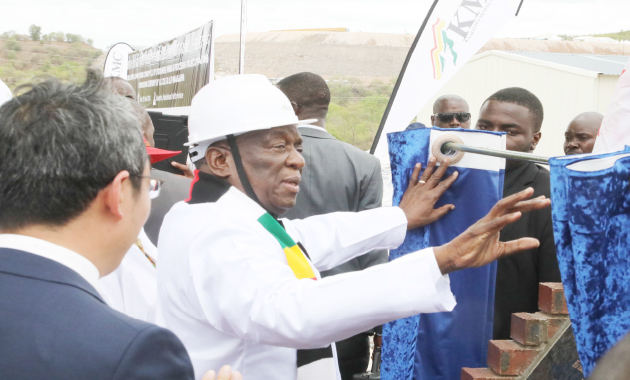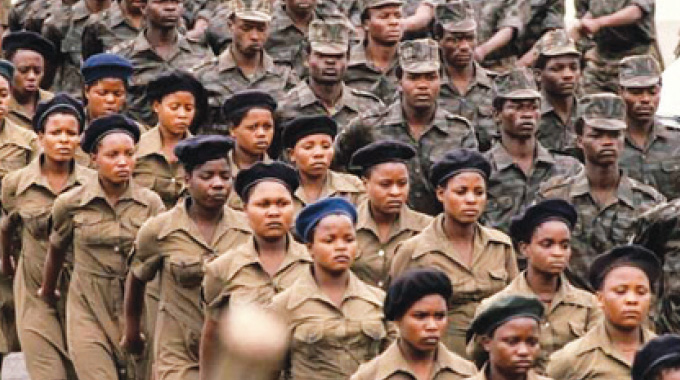Dombodema: great institution conceived in coffee shop
Saul Gwakuba Ndlovu
DOMBODEMA High School, which celebrated its golden jubilee yesterday is a by-product of Dombodema Mission founded in 1895 by Reverend George Cullen Harvey Reed of the London Missionary Society (LMS).
The LMS was formed in a London coffee house by a tiny group of determined men who were extremely eager to spread the Christian religion abroad. That period was characterised by an outbreak of Christian evangelism throughout the British Isles and the entire continental Europe.
One of the missionaries who came to southern Africa was Dr Robert Moffatt who in the early 1820s built a mission station among a Tswana tribe, the Tlaping (the word means fish) at a place called Kuruman.
It was from there that he and a team of clergymen travelled northwards to King Mzilikazi’s territory in 1859 to found Inyathi Mission.
After Mzilikazi’s death in 1868, the LMS were given in 1870 a piece of land some 16km south of Bulawayo by his successor, Lobengula, where they erected the second LMS mission in the Ndebele-ruled territory.
They named it Hope Fountain, in fact, a literal translation of the name of a local (at that time) perennial spring, Mthombothemba in isiNdebele. Inyathi was for male students only until the mid-1950s when girls were admitted to its secondary school department. Hope Fountain had been training female teachers only since 1916 till 1939 when it began to admit male students to that department. Earlier, from 1929, the LMS trained male teachers at Inyathi.
Meanwhile, Dombodema Mission had been established in 1895, two years after the defeat of Lobengula’s forces by those of Cecil John Rhodes’ British South Africa Chartered Company (BSACC). The first school was at Bhulu Khupe’s village while the founder of the mission, initially referred to as Bulilima Mission, the Rev Reed was constructing some temporary structures at the mission’s present site.
Located in Chief Manyiwa Nilukawo Nleya’s area, many of the chief’s people, and himself, were living at Ntemane, a region near where the current Zimbabwe-Botswana border post is located. Mzilikazi had given the LMS 8,000 acres of land at Inyathi; Lobengula offered the missionaries 6,000 acres at Hope Fountain; the BSACC regime granted them 24,000 square acres at Dombodema.
In hectage, the Inyathi Mission was slightly more than 3,636 hectares, Hope Fountain approximately 2,729 hectares and Dombodema was 10,909 hectares. Those lands were given to the LMS by this country’s successive administrators for the sole purpose of the propagation of Christianity to fulfil the initial objective of the LMS founders wish was “to spread the knowledge of Christ among heathen and other unenlightened nations.”
To become Christians, the target communities had to read the Bible referred to generally as the Book. That meant teaching them how to read also how to write. In addition to those two subjects, the missionaries also taught numeracy. Known as the three Rs, missionaries produced crash programmes to produce results in the shortest possible period.
Incidentally, the third R referred to a subject called arithmetic which, in fact, was the science of numbers, their sequence and how they were added, or multiplied, subtracted or divided. At Dombodema, the first prominent black teacher was a Kalanga man from Bechuanaland Protectorate (now Botswana) he was respectfully called Tata Sibutseng Moyo.
It is very interesting to note that Sibutseng later became the maternal grandmother of Angeline Kamba, one of the first three black female university graduates of this country. Kamba’s mother, Tshikana, was a product of the Hope Fountain teacher training department. Tata Sibutseng (the father of Sibutseng) was followed by a South African of Xhosa extraction called Magau who in turn was followed by Tshukuru (Tata Tom) Kulube, a local product of the LMS.
Tata Tom’s successor was another Xhosa, a Makheba. Then came Cephas Hlabangana, a son of the Reverend Sitjehkwa Hlabangana who had been ordained by the LMS at Tiger Kloof in 1921. Cephas Hlabangana was an elder brother of Tennyson Hlabangana, in whose honour Hope Fountain was later named.
The two brothers were the first black people to become university graduates in Southern Rhodesia. Cephas remained in South Africa as a teacher but Tennyson returned home to teach at Hope Fountain in 1947. He died of asthma at the Bulawayo General Hospital the following year (1948) and was deeply mourned by the whole LMS community in Southern Rhodesia, South Africa, Botswana and the United Kingdom.
Among his professional colleagues at Hope Fountain was President Mugabe who at that time was not yet a university graduate. Cephas returned from South Africa in the early 1960s, bought and lived in a house in Bulawayo’s Mpopoma South suburb and became one of 14 black MPs of the “B” Roll seats in 1962.
He was a member of Sir Edgar Whitehead’s United Federal Party (UFP). He died a few years later. Meanwhile, at Dombodema after Hlabangana’s departure for South Africa in 1930, a local, Pute Nelson Matjiwana Ndlovu, became the head teacher, as headmasters were then called.
A great deal of infrastructural development was carried out during his time.
Leading the community in this was a school committee chaired by Lugondo Khupe, a local Christian pioneer who had been baptised on April 13, 1902 with six other local men.
The six were Mongwa Tshibamani Tjuma, his cousin Thebe Tjuma, Nduna Tjalebgwa Moyo, his brother Tjiliwa Tjalebgwa Moyo, Kufa Fuma Nleya and Kufa’s cousin Tapela Nleya. Khupe, Mongwa and Nleya were later sent to Tiger Kloof to train as teachers.
On their return, they were deployed to various centres where the LMS had noticed a strong community wish to acquire education.
Mongwa later went back to Tiger Kloof to train as a minister. On his return, he was posted at Kezi in the Matobo District where he was received by a Hlogwane, a South African-born LMS school teacher.
Mongwa later moved to nearby Zamanyoni from where he duly founded and superintended a large number of primary schools.
At Dombodema, PN Ndlovu had introduced Standard Four. In 1939 he left school teaching and went to Tiger Kloof to do a ministerial course which he completed in 1942.
In his place came another local, who had been teaching at Inyathi, Daniel Hilton Makhulela Dube, popularly called “DHD’’ for short.
He was the father of Angeline Kamba, his first-born. Dube was succeeded by Amos Dambe (Tjuma) from Masunga in the then Bechuanaland Protectorate in 1943 when Standard Five was introduced into the school.
Dambe’s services were terminated by the missionaries before the end of the year because he had impregnated a school mistress who was one of his assistant teachers. PN Ndlovu (now Reverend Ndlovu) had to act as the school head for the remaining part of 1943.
The following year (1944) Dombodema Central Primary School was under Timothy Kumile Masola’s headship. He remained for only a year and then back came “DHD” who remained for two years: 1945-46. “DHD” was followed by Dlamini Wilson Muwutshiwa Kulube (Tata Tjiboyi) who soldiered on till the end of 1952.
He had introduced Standard Six in 1947. Kulube was succeeded by John Prescott, an Australian. He did not last long as he left to head a school in southern Manicaland. Later Jonathan Kumile Masola, a younger brother of Timothy, became the head teacher.
We should remember that because of the then government policy of racial discrimination, also known as colour-bar, black heads of schools were called “head teachers” but whites were referred to as “principals.”
Before the introduction of Standard Six, Dombodema pupils went to either Inyathi or Hope Fountain for Standard Six with Inyathi taking boys and Hope Fountain girls.
A few went to the nearby Methodist (Wesleyan) Tegwane (now Tekwane) Mission which had been established by Reverend Herbert Carter in 1897, the same year as the Seventh Day Adventists’ Solusi Mission in the same district, then known as Bulilimamagwe.
Empandeni Roman Catholic Mission also took quite a few Dombodemans for Standards Five, Six and teacher training. A couple of former Dombodema students trained as builders at both Empandeni and Embakwe Roman Catholic Institution near Empandeni.
Dombodema took a big step forward when it opened a higher teacher training school in 1955. An AE Walden was transferred from Inyathi Secondary School to be the principal of that college.
At Hope Fountain, the principal, MacD. Partridge, was, meanwhile, toying with the idea of establishing a non-denominational teacher-training institution in Bulawayo.
It eventually materialised as the United College of Education and both Dombodema and Hope Fountain as a result closed down their respective teacher training departments. Dombodema Secondary, later High School, was established in 1964 with a Bending, formerly of the teacher-training college, as its first headmaster.
Many of its 517 students are from the 30-plus former kraal schools that fell under the Dombodema circuit whose LMS clergymen had been Reed, WW Anderson, John Whiteside, Reverend Matebesi, CE Segar, Paul S King, Reverend Hoard, Reverend Pelling, Reverend Nyoni, Reverend J Danisa and of course, Reverend PN Ndlovu who was based at the mission since 1943 shortly after he was ordained.
The list is not in a strictly historical succession order.
Several other ministers took charge of the Dombodema circuit following the LMS’ change of name to the United Congregational Church of Southern Africa (UCCSA) in August 1967.
It is most appropriate to wind up this historical background with the words of Reverend Amos Mzilethi who was based at Inyathi and superintended at least 13 kraal schools that were in the Inyathi circuit.
In his 1950 report, the clergymen stated: “Educationally our people have struck their tents, and are on the march. They are bursting into civilisation overnight. But whither?” we can say that instead of “…….bursting into civilisation…….” we may say; “Our people are now lighting their way educationally into the twenty-first century, and that with God’s guidance, some of Dombodema’s educational products will contribute intellectually, spiritually and manually to the development of Zimbabwe, and will leave it a much better society than when they found it.”
That is the major role of Christian education, and that was exactly what those great men wished to achieve when they formed the LMS in the unidentified London coffee house in 1795.







Comments